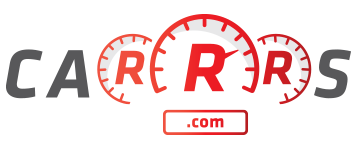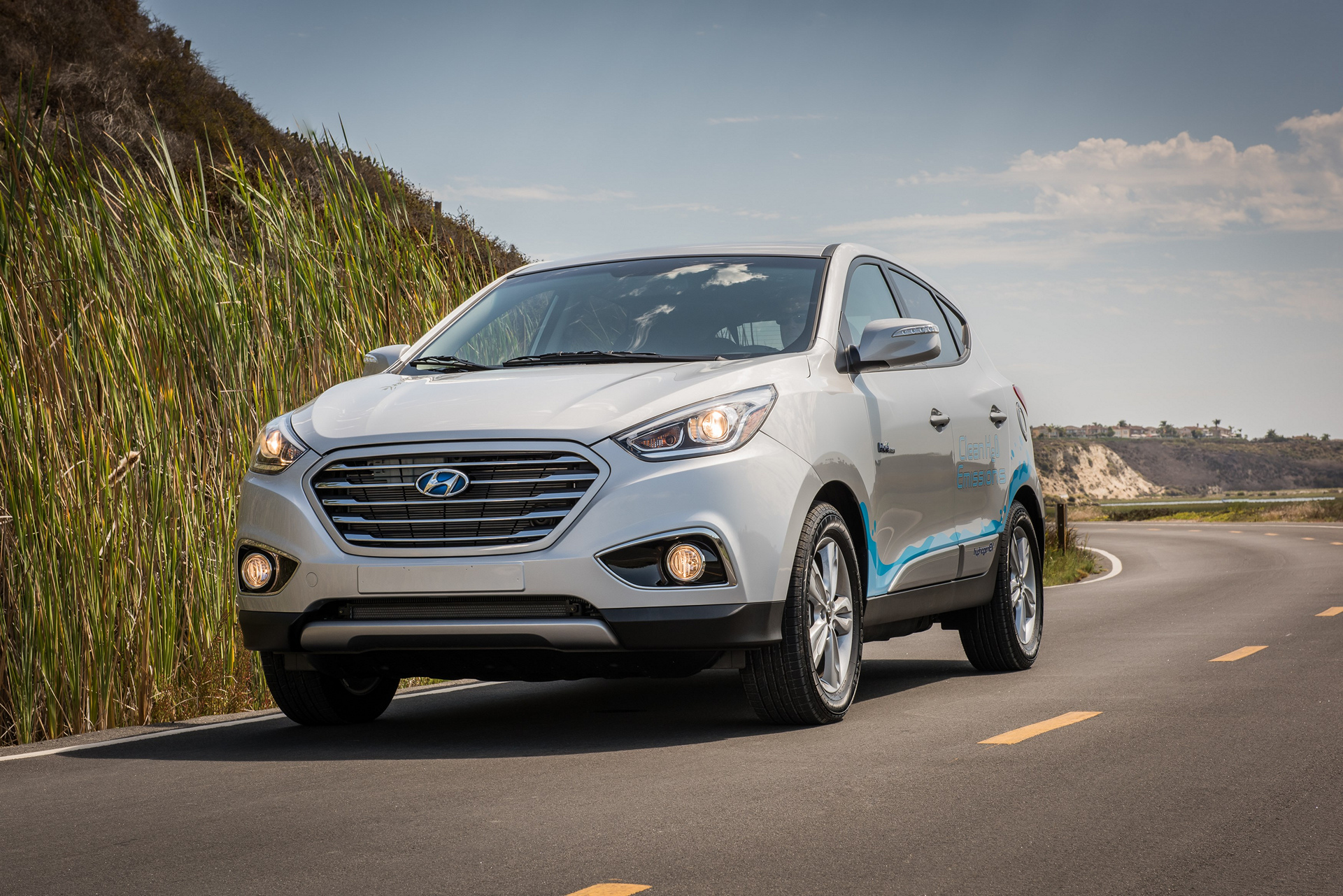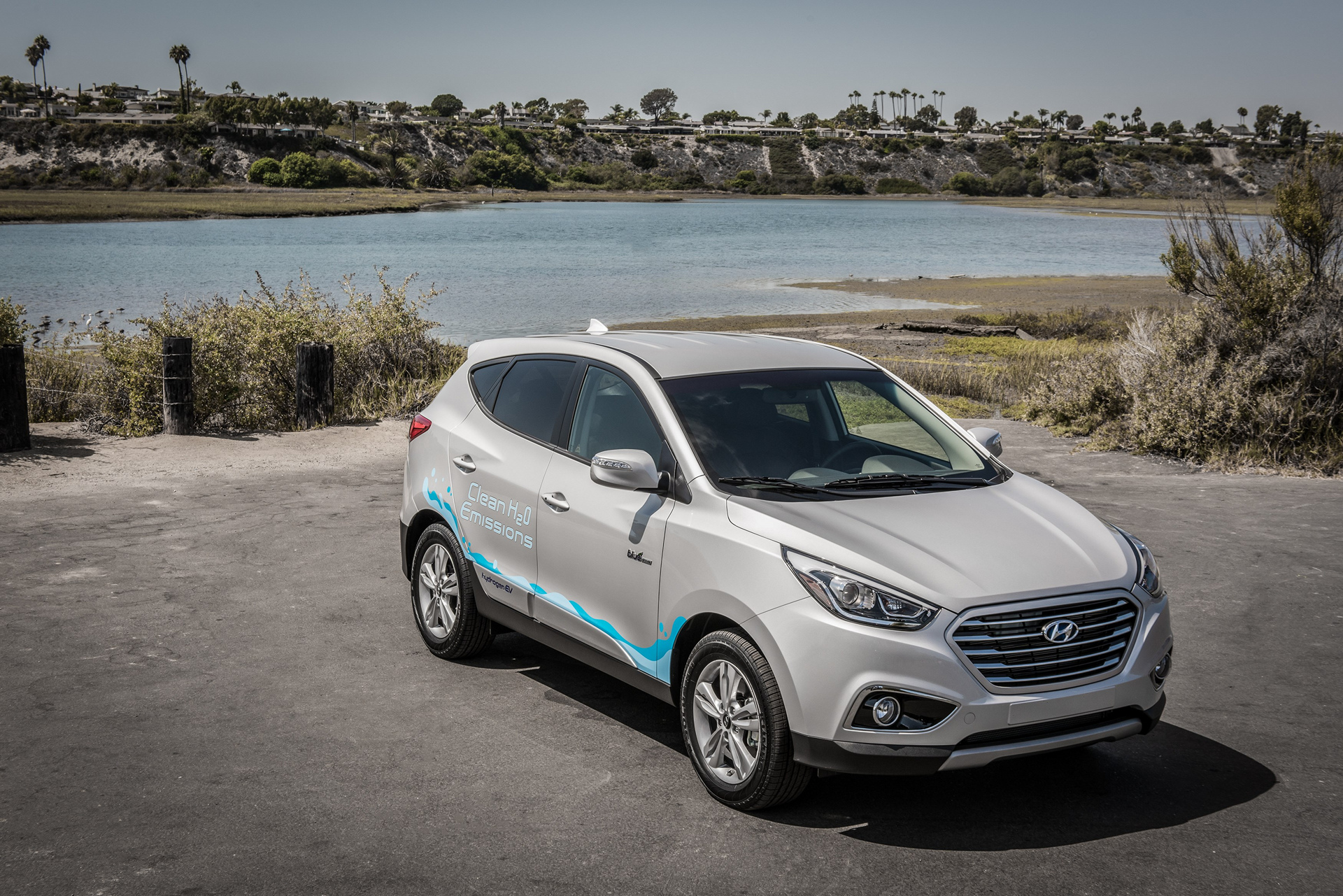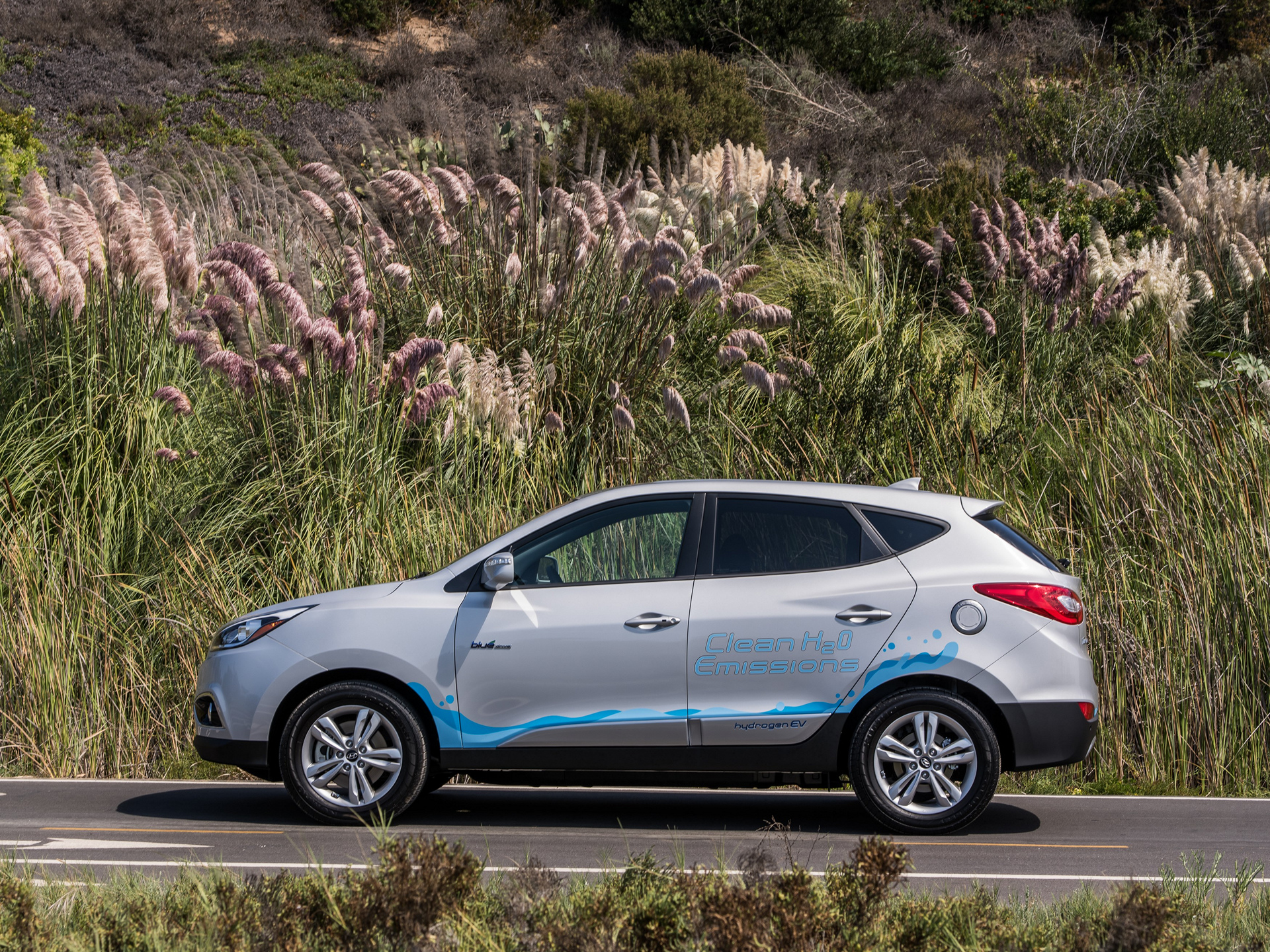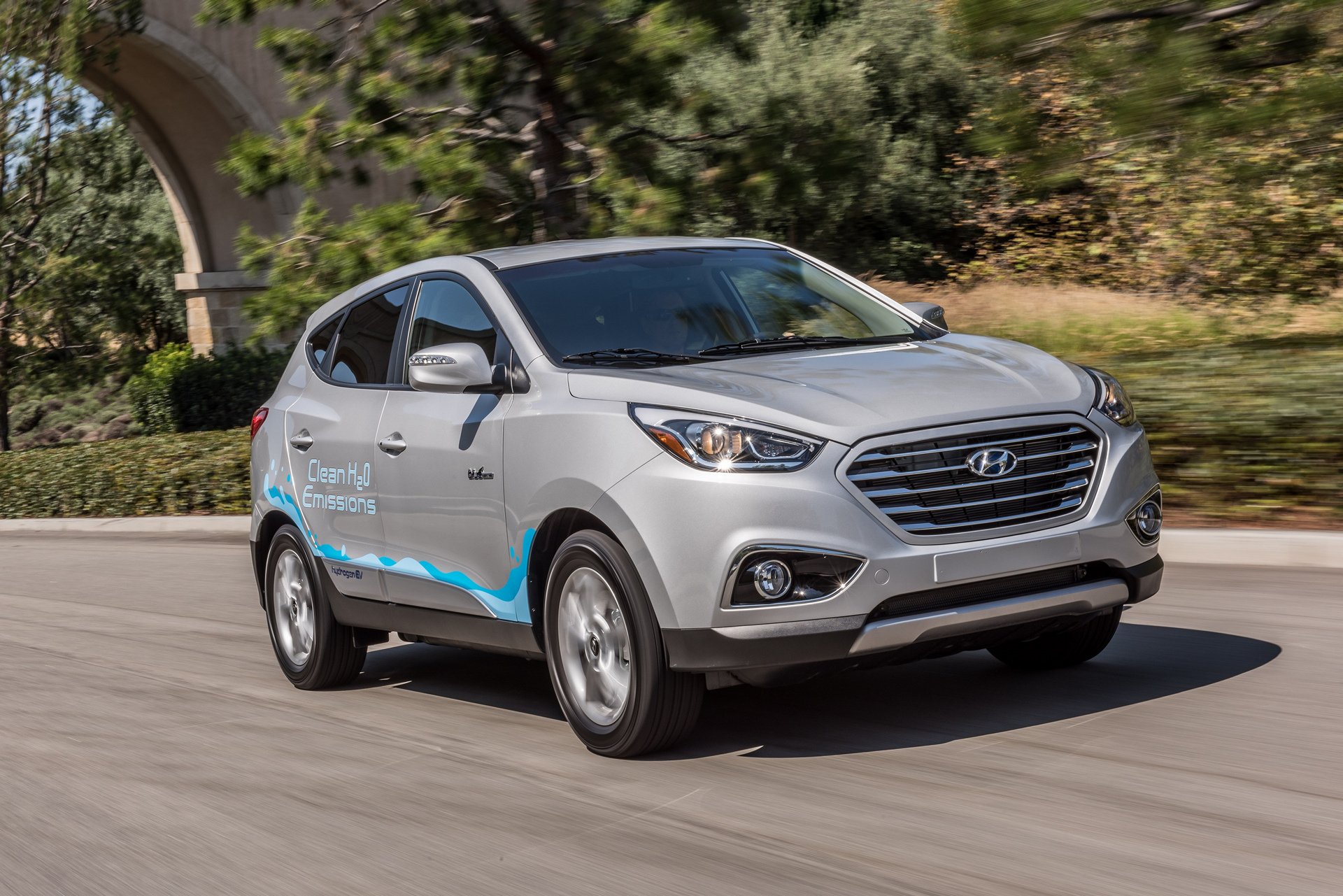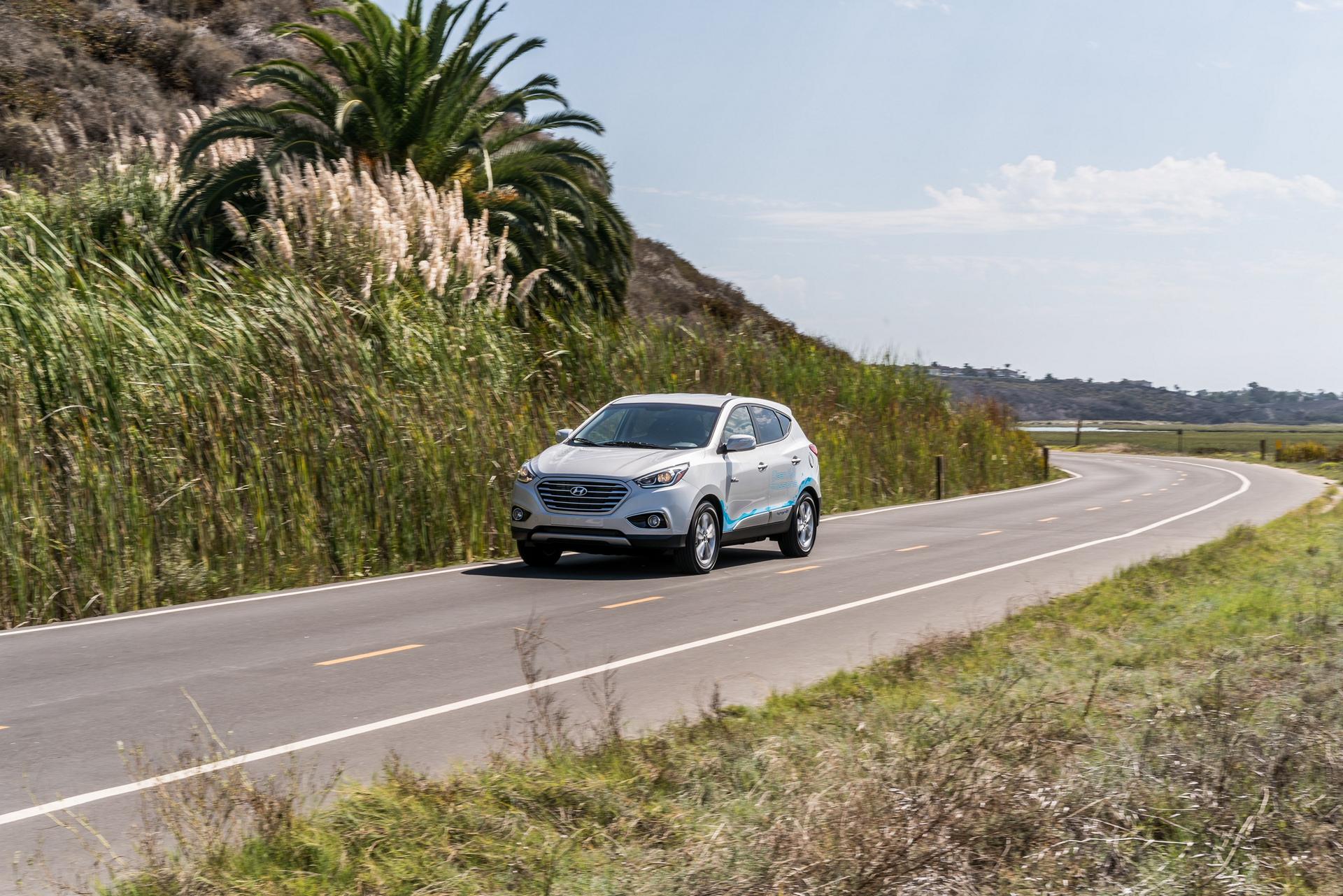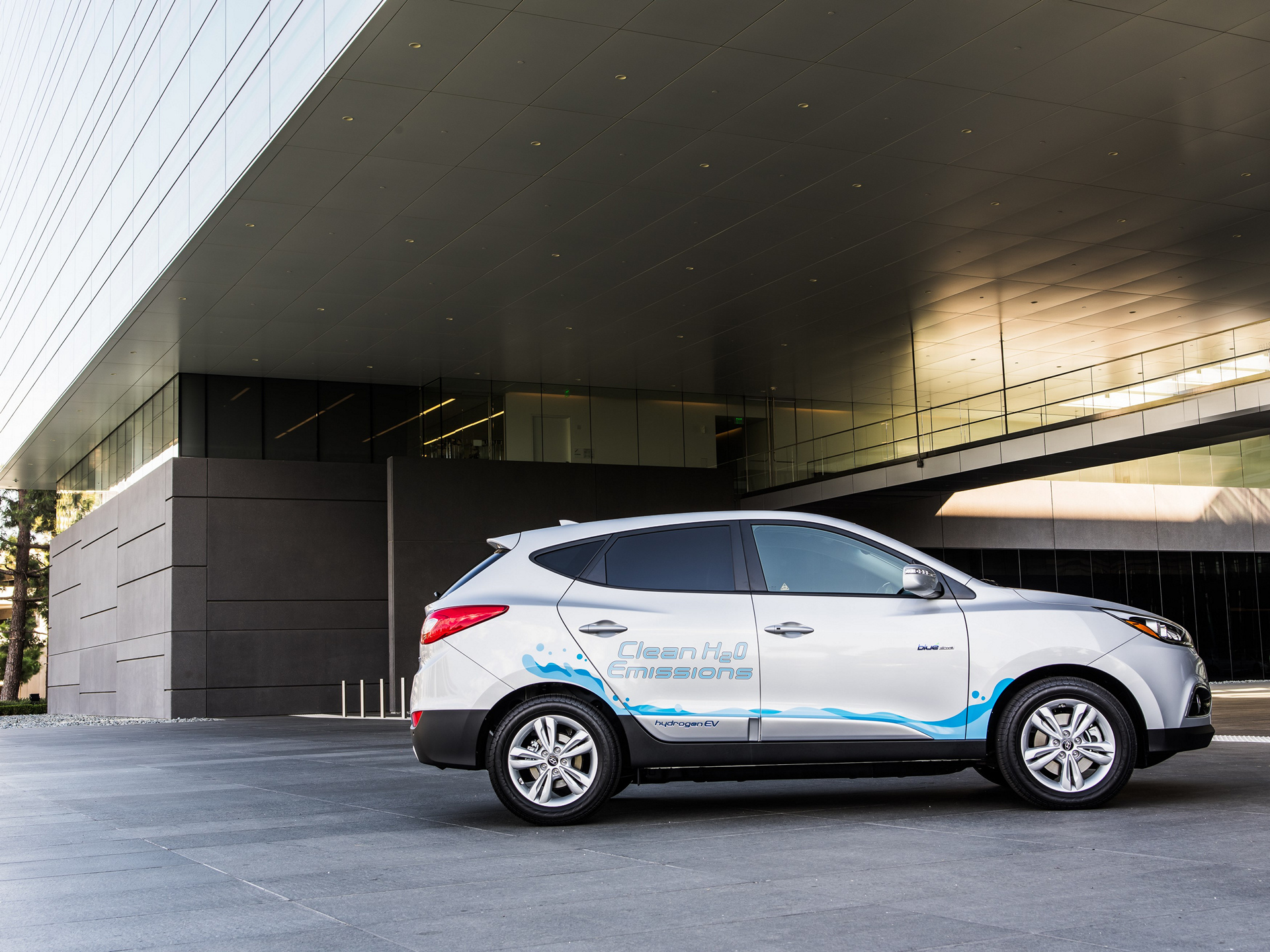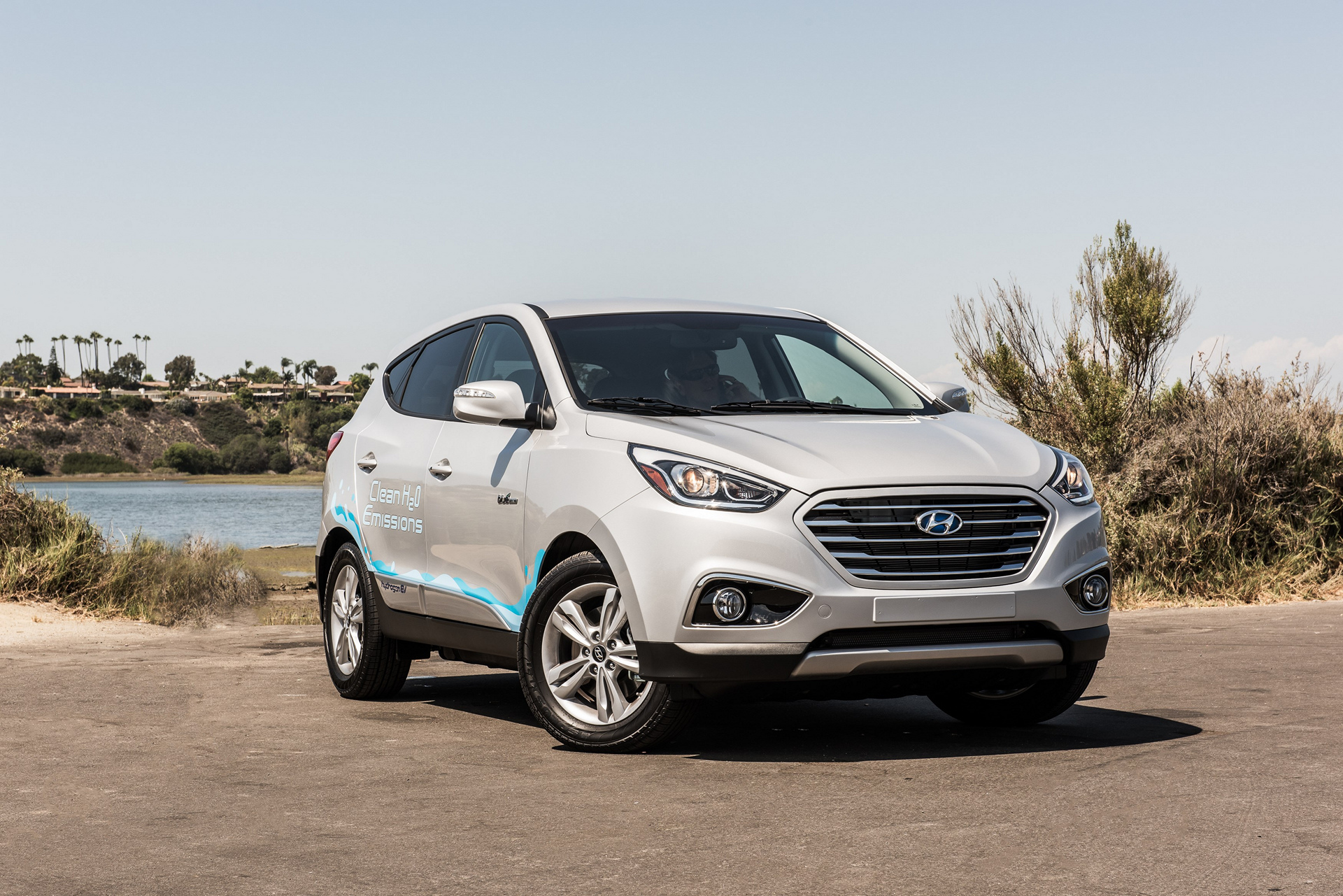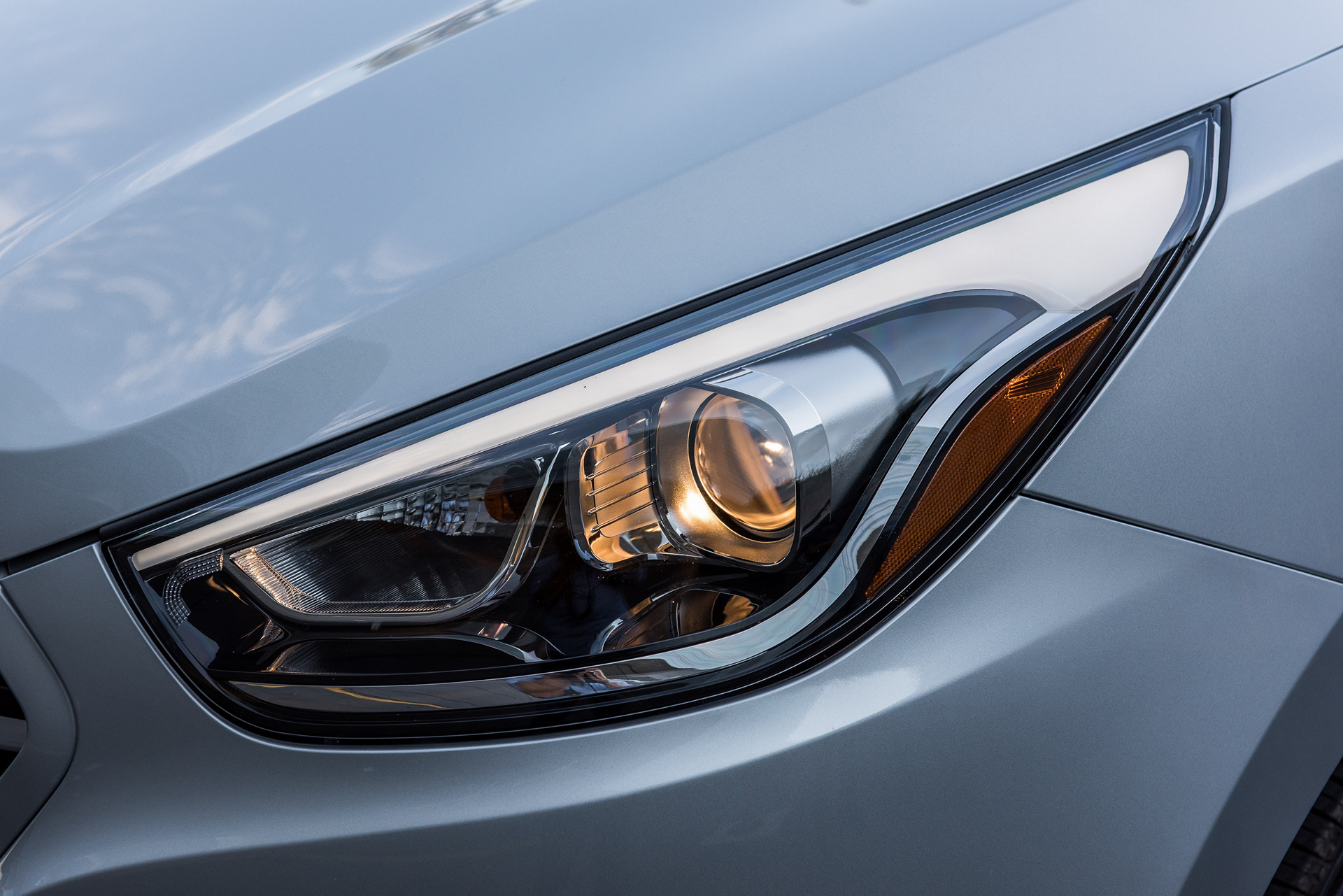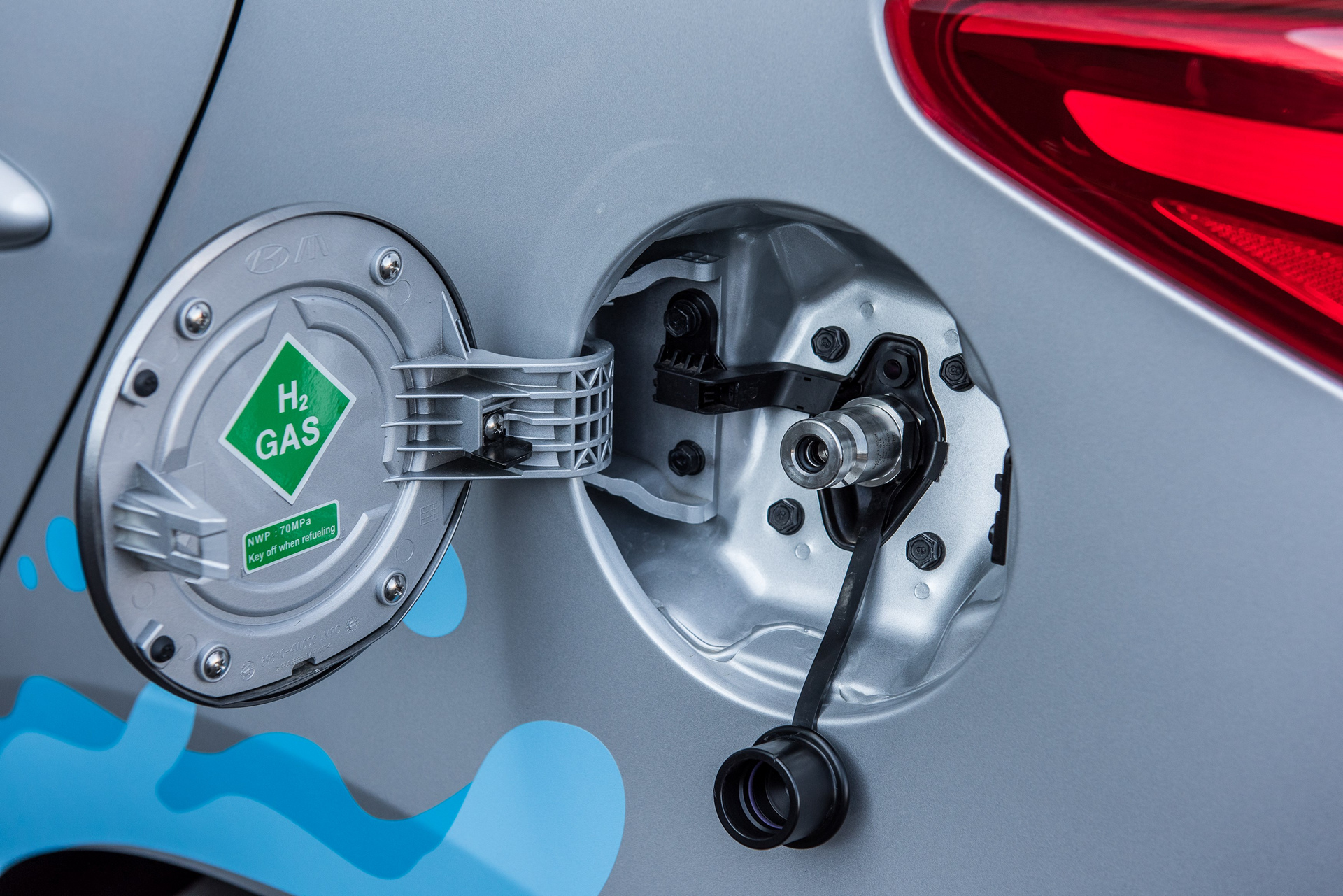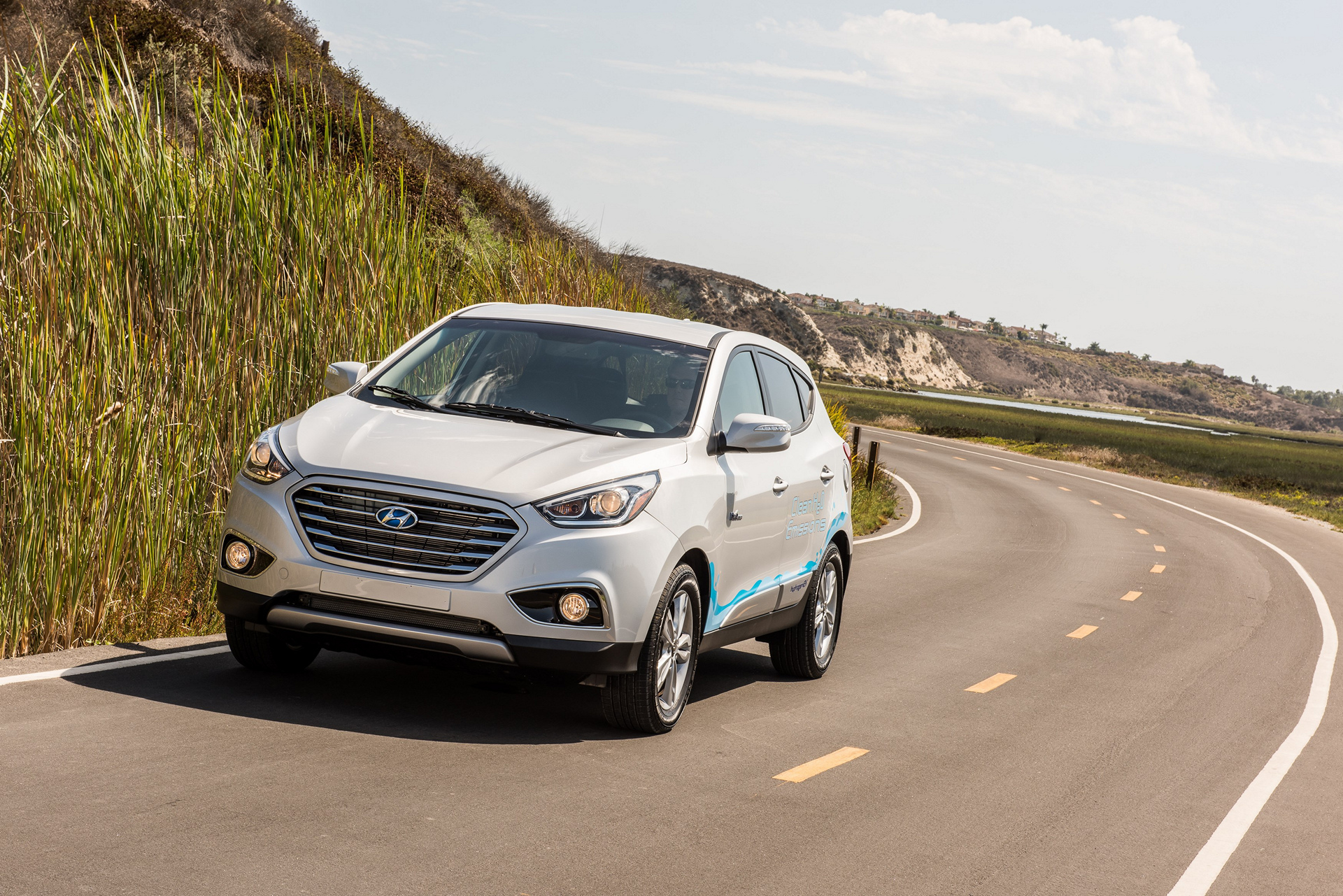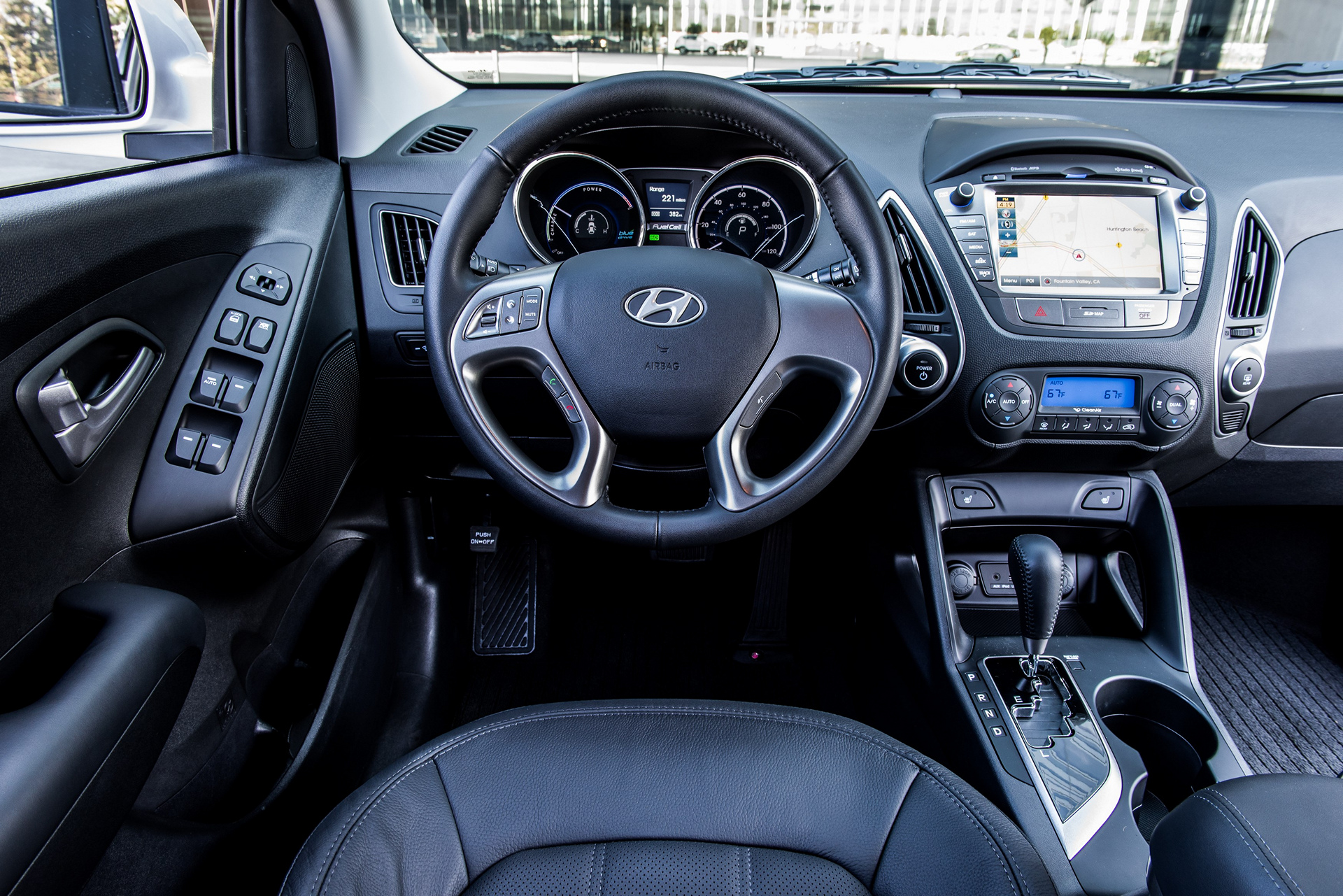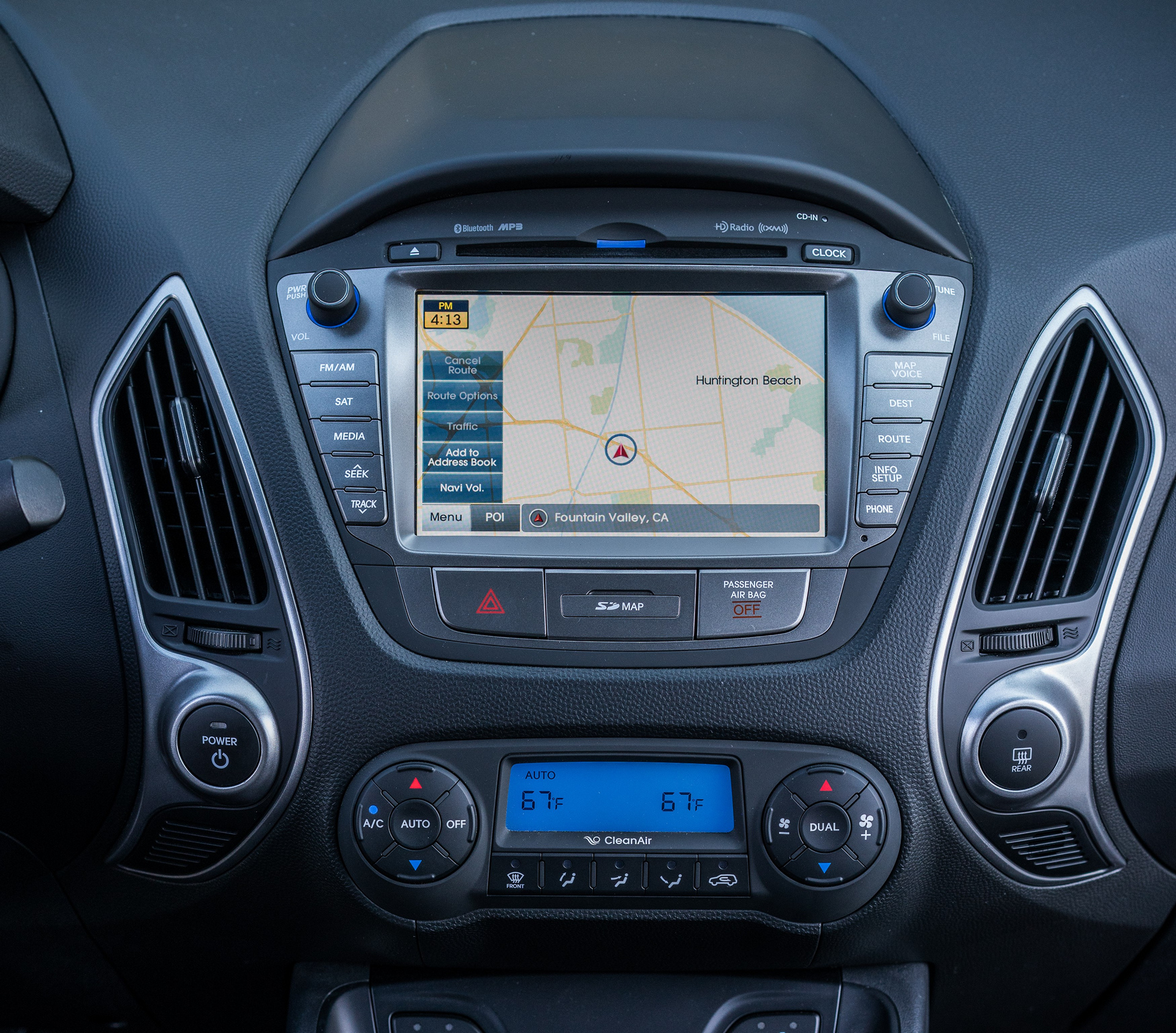Hyundai’s zero-emissions, hydrogen-powered Tucson Fuel Cell vehicle continues to satisfy and attract new customers focused on high-versatility and clean transportation. For 2016, the Tucson Fuel Cell adds convenient HomeLink® connectivity to the mirror, allowing owners to open and close garage doors, security gates and even control home lighting systems via a button on the rearview mirror, which includes a digital compass.
In addition, Tucson adds two new exterior color options to Winter White: Hydro Blue and Chromium Silver.
“At Hyundai, we strongly believe that hydrogen-powered fuel cell vehicles represent the next generation of zero-emission vehicle technology, and we’re proud to be a leader in offering the mass-produced Tucson Fuel Cell to our customers,” said Dave Zuchowski, president and chief executive officer, Hyundai Motor America. “Every day, these customers are enjoying the benefits of refueling speed and superior range that compare favorably with gasoline vehicles, providing a seamless transition from traditional vehicles with minimal loss of utility. We’re confident that advancing fuel cell technology will increase the adoption of zero-emission vehicles, and that everyone will benefit.”
The Hyundai Tucson Fuel Cell has also received strong support from government agencies, such as the California Air Resources Board.
“These ultra-clean vehicles play a critical role in our efforts to clean the air and meet our climate goals,” said Air Resources Board chairman Mary D. Nichols. “Fuel cell cars are not vehicles of the future – they’re here now, and we applaud Hyundai for bringing them first to market in California where they are most needed.”
Fuel Cell Pricing and Benefits
The Tucson Fuel Cell lease program remains unchanged for 2016. Customers in the Los Angeles/Orange County region can drive Hyundai’s next-generation Tucson Fuel Cell for just $499 per month for a 36-month term, with a $2,999 down payment. This includes the addition of a remarkable benefit – unlimited complimentary hydrogen refueling and At Your Service Valet Maintenance at no extra cost.
“When we spoke with customers about fuel cell vehicles, many wondered about the cost of hydrogen,” explained Mike O’Brien, vice president, corporate and product planning. “To ease those concerns as the hydrogen refueling network builds out, we decided that covering this cost for these early adopters was appropriate, and consistent with how we like to treat our customers.”
In addition, Tucson Fuel Cell owners will enjoy similar services enjoyed by Hyundai Equus owners, such as At Your Service Valet Maintenance, at no extra cost. Similar to what Equus owners have enjoyed since its introduction in 2010, should a Tucson Fuel Cell require any service, a Hyundai dealer will pick up the vehicle and provide a loan vehicle, then return the car after service to the customer’s home or business, at no charge.
Customers interested in the Tucson Fuel Cell can indicate their interest (the first step in the ordering process) by visiting Hyundai.com. Retail consumers can find availability at three select southern California Hyundai dealers: Win Hyundai in Carson, Tustin Hyundai, and Hardin Hyundai in Anaheim. Availability of the Tucson Fuel Cell will expand to other regions of the U.S. consistent with the accelerating deployment of hydrogen refueling stations.
Tucson Fuel Cell Advantages
Hyundai has developed its Tucson Fuel Cell to alleviate some of the range and utility limitations of traditional battery electric vehicles. The Tucson Fuel Cell maintains the day-to-day flexibility of the gasoline-powered Tucson, so that its driver is able to fulfill their transportation needs without range or recharging-time concerns to their lifestyle.
The Tucson Fuel Cell is an advanced electric vehicle – one that creates its own electricity, on-board, from hydrogen. According to the University of California, Irvine Advanced Power and Energy Program’s 2013 study, the hydrogen fuel cell provides comparable total well-to-wheel emissions to a battery electric vehicle. For the Tucson Fuel Cell driver, this social benefit is achieved with greater utility, versatility and without compromises. Consider:
- Driving range of 265 miles
- Refueling time similar to gasoline vehicle of same size
- Minimal reduction in daily utility compared with its gasoline counterpart
- Instantaneous electric motor torque
- Minimal cold-weather effects compared with battery-electric vehicles
- Superb daily reliability and long-term durability
– No moving parts within the power-generating fuel cell stack
– More than two million durability test miles on Hyundai’s fuel cell fleet since 2000
– Extensive crash, fire and leak testing successfully completed
– Quieter EV operation
– Zero greenhouse-gas emissions, emits only water vapor
The Tucson Fuel Cell began mass production in February 2013 at the Ulsan, Korea assembly plant that also manufactures the Tucson gasoline-powered CUV. Manufacturing the Tucson Fuel Cell at the same plant allows Hyundai to leverage both the high quality and cost-efficiency of its popular gasoline-powered Tucson platform.
Hydrogen Renewable Energy Solutions
The benefits of hydrogen are well known – required supplies for the U.S. market can be produced domestically and its supply is virtually unlimited. It can be produced by varied means – including renewable sources such as biogas. Hydrogen can even be sourced directly from water, using electrolysis to split hydrogen molecules with electricity from renewable energy sources such as wind and solar.
Further supporting hydrogen infrastructure development, California approved a plan in 2013 to develop up to 100 hydrogen refueling stations in the state over the next several years. This recent California initiative dovetails with increased government support of hydrogen infrastructure development at the federal level, such as H2USA. In addition, the California Energy Commission recently announced proposed awarding of $44.5 million for the development of 28 new hydrogen stations (plus one mobile refueler), bringing the total number of hydrogen fueling stations (open, in-development, and proposed) to over 50 stations.
Fuel Cell Technology: How It Works
Hyundai’s fuel cell effectively replaces the battery pack used in an electric vehicle by generating electricity from hydrogen through an electrochemical process that does not involve hydrogen combustion, with no moving parts within the fuel cell stack.
The fuel cell electrochemical process is as follows:
- Hydrogen enters the anode, air (oxygen) enters the cathode
- Catalyst splits the hydrogen electrons and protons
- Electrolyte conducts the positively-charged ions while blocking the electrons
- Electrons are used to create an external circuit, generating electricity
- Catalyst combines the hydrogen ions and electrons with oxygen to create water and heat energy
- A single fuel cell produces approximately one volt; fuel cells are “stacked” to meet voltage requirements
Specification
| Base | |
|---|---|
| Powertrain | |
| Fuel System | Hydrogen Fuel Cell |
| Fuel Cell Type | Proton Exchange Membrane |
| Fuel Cell Power (max) | 100 kW |
| Electric Motor Type | Induction |
| Battery Type | Li-Polymer |
| Battery Energy | 0.95 (kWh) |
| Battery Power (max) | 24 kW |
| Horsepower | 134 @ 5,000 rpm |
| Torque | 221 lb-ft @ 1,000 rpm |
| Transmission | |
| Single speed | - |
| Drive System | |
| FWD | - |
| Suspension | |
| Front | MacPherson struts with coil springs, gas pressurized shock absorbers and 27.2 mm hollow stabilizer bar |
| Rear | Torsion Axle, gas-pressurized shock absorbers and stabilizer bar |
| Shock absorbers | Sachs |
| Steering | |
| Type | Motor Driven Power Steering (MDPS) Rack and Pinion |
| Overall Ratio | 15:1 |
| Turns, lock to lock | 2.83 |
| Turning circle | 34.8 ft (curb-to-curb) |
| Brakes/ Tires/ Wheels | |
| Front | Power-assisted 320 mm x 28 mm vented disc |
| Rear | Power-assisted 284 mm x 10 mm solid disc |
| ABS | 4-wheel, 4-channel, 4-sensor with Electronic Stability Control (ESC) with Traction Control System (TCS) |
| Tires (low-rolling resistance) | P225/60R17 |
| Wheels | 17 x 6.5J alloy wheel |
| Exterior Dimensions | |
| Wheelbase | 103.9 in. |
| Overall length | 173.6 in. |
| Overall width (excludes mirrors) | 71.7 in. |
| Overall height | 65.2 in. |
| Tread width (front/rear) | 62.4 in. / 62.8 in. |
| Overhang (front/rear) | 34.6 in. / 35.0 in. |
| Minimum Ground Clearance | 6.5 in. |
| Coefficient of drag (Cd) | 0.35 |
| Interior Dimensions | |
| Head room | |
| Front | 39.4 in |
| Rear | 39.1 in |
| Leg room | |
| Front | 41.2 in |
| Rear | 38.1 in |
| Shoulder room | |
| Front | 57.1 in |
| Rear | 55.1 in |
| Hip room | |
| Front | 53.8 in |
| Rear | 52.6 in |
| EPA passenger volume | 101.2 cubic ft. |
| EPA cargo volume, rear seats up | 23.8 cubic ft. |
| EPA cargo volume, rear seats folded down | 53.8 cubic ft. |
| Capacities | |
| Maximum hydrogen storage capacity | 5.63 Kg (12.4 lbs) |
| Curb Weight | |
| FWD | 4,101 lbs |
| GVWR | |
| FWD | 4,960 lbs |
| Fuel Economy | |
| FWD with automatic transmission | |
| City | 49 MPGe |
| Highway | 51 MPGe |
| Combined | 50 MPGe |
Features
| Base | |
|---|---|
| Functional Features | |
| Body Construction: | |
| High Tensile Steel monocoque body | S |
| Fuel System: | |
| Hydrogen Fuel Cell | S |
| Steering: | |
| Motor Driven Power Steering (MDPS) | S |
| Suspension: | |
| Front: MacPherson strut with coil springs, 27.2-mm, hollow-type stabilizer bar and gas-pressurized shock absorbers | S |
| Rear: Torsion axle with stabilizer bar and gas-pressurized shock absorbers | S |
| SACHS premium shock absorbers | S |
| Transmission/Drive System: | |
| Single Speed | S |
| Front Wheel Drive | S |
| Regenerative brake system | S |
| Virtual Engine Sound | S |
| Battery Saver | S |
| 17 x 6.5J J Alloy Wheels | S |
| Kumho H-speed rated tires, low-rolling resistance compound | S |
| Exterior Features | |
| Projector headlamps with LED headlight accents | S |
| Roof-mounted Center High-mount Stop Lamp (CHMSL) | S |
| Front fog lights | S |
| Automatic headlights | S |
| LED taillights | S |
| Outside mirrors, dual fold-away power, body-color | S |
| Heated outside mirrors | S |
| Side Repeater exterior mirrors | S |
| Power Folding Mirrors | S |
| Bumpers, body-color | S |
| Grille, Body-color/Black (unique grille) | S |
| Door window frame color, matte black | S |
| Window belt moldings, black | S |
| Door handles, body-color | S |
| Side Garnish, metallic look | S |
| Fuel Door, metallic surround | S |
| Backup warning sensors | S |
| Tinted glass, windshield | S |
| Privacy glass, rear/quarter/back glass | S |
| Windshield shade band | S |
| Front 2-speed/variable intermittent windshield wipers | S |
| Front windshield wiper de-icer | S |
| Intermittent rear window wiper/washer (non-variable) | S |
| Rear spoiler, integrated with HMSL, body-color | S |
| Tire Mobility Kit | S |
| Fuel Cell Badging | S |
| Interior Features | |
| Leather-wrapped steering wheel | S |
| Steering wheel, tilt and telescoping | S |
| Steering wheel-mounted audio and Bluetooth® controls | S |
| Door armrest, integrated | S |
| Door map pockets with bottle holders, front and rear | S |
| Sunvisors with vanity mirror with cover, illumination, extension, and ticket holder | S |
| Shift knob, leather | S |
| Carpeted floor mats | S |
| Luggage net hook and net | S |
| Dual automatic temperature control with CleanAir Ionizer | S |
| External temperature gauge | S |
| Rear seat heater ducts | S |
| Cabin air filter | S |
| Rear window defroster with timer | S |
| Front map lights with sunglass holder | S |
| Glove compartment light | S |
| Cargo area light | S |
| Illuminated power window switches | S |
| Trip computer (distance to empty, average fuel consumption, average vehicle speed, elapsed time) | S |
| Triple Turn Signal | S |
| Power windows with driver auto-down, front switches illuminated | S |
| Power door locks with speed sensing auto door locks | S |
| Remote keyless entry system with alarm and panic | S |
| Proximity key entry with push button start | S |
| Remote hood and fuel door release | S |
| Storage tray (below 12-volt outlet) | S |
| Front center console, armrest storage box | S |
| Front center console-mounted dual cup holders | S |
| Rear center armrest with cup holders | S |
| 12-volt outlets (3), front (2) / cargo (1) | S |
| iPod®/USB/auxiliary input jacks | S |
| Assist grips (3) | S |
| Glove compartment, damper/locking | S |
| Inside electrochromatic rearview mirror with compass | S |
| Rear bag hook | S |
| 5-passenger seating | S |
| Seating surface, leather | S |
| Front seats active head restraints, adjustable | S |
| Heated front seats (high/low) | S |
| Power driver seat (power recline, slide, height, lumbar) | S |
| 60/40 split fold-down rear seatback with adjustable head restraints | S |
| Heated rear seats | S |
| Rear seat back pockets | S |
| Driver and front-passenger advanced airbags (2) | S |
| Occupant Classification System (OCS) seat weight sensor and seat track sensor | S |
| Driver and front passenger side-impact airbags FR (Thorax) (2) | S |
| Roof-mounted side curtain airbags with rollover sensors (2) | S |
| Outboard seatbelts, 3-point/ELR | S |
| Inboard seatbelt (rear), 3-point/ELR | S |
| Adjustable front-seat shoulder belt anchors | S |
| Front seatbelt pretensioners and load limiters | S |
| LATCH Lower Anchors and Upper Tether Anchors | S |
| Power window lock-out button | S |
| Child safety locks (rear) | S |
| Anti-lock Braking System (ABS) with 4-wheel disc brakes | S |
| Electronic Stability Control (ESC) with Traction Control (TCS) and Brake Assist | S |
| Vehicle Stability Management | S |
| Tire Pressure Monitoring System (TPMS) | S |
| Hillstart Assist Control (HAC) | S |
| 2.5-MPH bumpers | S |
| Body-side reinforcements | S |
| Anti-theft system and immobilizer | S |
| ABS with Electronic Brake-force Distribution | S |
| Meters/Gauges: speedometer, power meter, coolant temperature, fuel level, digital odometer, trip odometer, electroluminescent gauge cluster and TFT LCD info | S |
| Indicators: PRND, turn signal/hazard, high beam, fog lights, brake, and immobilizer | S |
| Warning lights: battery charge, door ajar, airbag, seatbelt, low fuel, trunk lid open, brake, check engine, ABS, TPMS, ESC, and EPS | S |
| Warning chimes: Key-in-ignition with door ajar and seatbelt | S |
| Adjustable illumination level | S |
| 360-watts AM/FM/SiriusXM/HD Radio/CD/MP3 audio system with amp and 7 speakers (2 front-door mounted, 2 Tweeters, 2 rear, and subwoofer) with Navigation, 7" high-resolution touch-screen display | S |
| Bluetooth® hands-free phone system with voice recognition (navigation includes audio/navigation/calling commands) | S |
| Roof-mounted AM/FM/Satellite radio antenna | S |
| Digital clock | S |
| Rearview camera | S |

